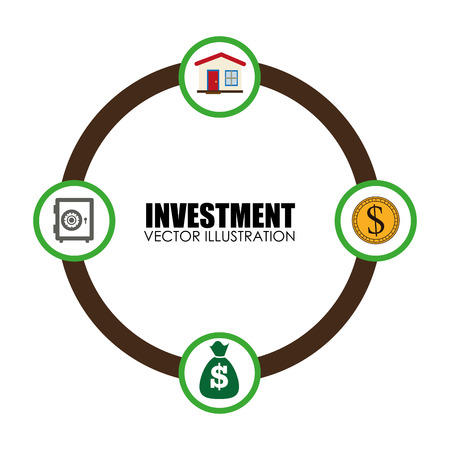1. Understanding GDP and Its Role in the Economy
Gross Domestic Product (GDP) is one of the most important indicators used to gauge the health of an economy. It represents the total monetary value of all goods and services produced within a countrys borders over a specific period, usually measured quarterly or annually.
What Is GDP?
GDP is essentially the economic output of a nation. It helps economists, policymakers, and investors understand how fast or slow an economy is growing. A rising GDP typically signals economic expansion, while a declining GDP may indicate a slowdown or recession.
How Is GDP Measured?
There are three primary ways to calculate GDP:
(1) Production Approach
This method calculates GDP by adding up the total value of goods and services produced in different industries.
(2) Expenditure Approach
This approach sums up all spending on final goods and services in an economy, categorized into four components:
| Category | Description |
|---|---|
| Consumer Spending (C) | Total spending by households on goods and services. |
| Business Investment (I) | Expenditures on capital goods like machinery, buildings, and technology. |
| Government Spending (G) | Total government expenditures on public services and infrastructure. |
| Net Exports (X – M) | The value of exports minus imports. |
(3) Income Approach
This method calculates GDP by summing all incomes earned in an economy, including wages, profits, rents, and taxes minus subsidies.
Why Is GDP Important?
GDP serves as a key indicator of economic health for several reasons:
(1) Economic Growth Indicator
A growing GDP suggests that businesses are expanding, jobs are being created, and consumers have more money to spend.
(2) Impact on Investments
The stock market often reacts to changes in GDP growth. A strong GDP report can boost investor confidence, leading to higher stock prices.
(3) Government Policy Decisions
The Federal Reserve and policymakers use GDP data to adjust interest rates, taxation policies, and government spending to manage economic stability.
2. The Relationship Between GDP Growth and the Stock Market
Understanding how GDP growth influences the stock market can help investors make informed decisions. Historically, there has been a strong correlation between economic expansion and stock market performance. When GDP rises, businesses generally perform better, leading to higher corporate earnings and increased investor confidence. However, the relationship is not always straightforward, as other factors also play a role.
Key Factors Linking GDP Growth and Stock Market Performance
Several factors contribute to the connection between GDP growth and stock market trends. Here are some of the most significant ones:
(1) Corporate Earnings and Profitability
As GDP grows, businesses tend to generate higher revenues and profits. This often leads to rising stock prices, as investors anticipate stronger future earnings.
(2) Consumer Spending and Demand
A growing economy typically means higher employment rates and increased consumer spending. Since consumer spending drives business revenue, stock prices often follow suit.
(3) Investor Sentiment and Market Confidence
During periods of economic expansion, investors tend to be more optimistic about future returns. This positive sentiment can drive stock prices higher.
(4) Interest Rates and Monetary Policy
The Federal Reserve adjusts interest rates based on economic conditions. Lower rates during economic growth can make borrowing cheaper for businesses, boosting investment and stock valuations.
Historical Trends: How GDP Growth Has Influenced the Stock Market
Looking at historical data can provide insights into how GDP growth impacts the stock market. Below is a table summarizing key periods of U.S. economic growth and their corresponding stock market trends:
| Period | GDP Growth Rate | S&P 500 Performance |
|---|---|---|
| 1990s (Tech Boom) | Around 3-4% annually | Sustained bull market, tech stocks surged |
| 2008-2009 (Great Recession) | -2.5% in 2009 | S&P 500 dropped over 50% before recovering |
| 2010s (Post-Recession Recovery) | Around 2-3% annually | Sustained market growth with record highs |
| 2020 (COVID-19 Impact) | -3.4% in 2020 | Market crash followed by rapid recovery |
The Limits of GDP as a Stock Market Indicator
While GDP growth is an important factor in stock market performance, it is not the only determinant. Other elements such as geopolitical events, inflation levels, corporate earnings reports, and government policies can also influence market movements.

3. Sectors That Benefit the Most from GDP Growth
When the economy is expanding, certain industries tend to thrive more than others. Investors often look to these sectors for potential growth opportunities as consumer spending increases, businesses invest more, and overall confidence in the market improves.
Key Industries That Thrive During Economic Growth
The following sectors typically benefit the most when GDP is on the rise:
(1) Consumer Discretionary
As people have more disposable income during periods of economic growth, they are more likely to spend on non-essential goods and services. This sector includes companies in retail, travel, entertainment, and luxury goods.
(2) Financial Services
With a growing economy, lending activity increases as both businesses and individuals take out loans for expansion and major purchases. Banks, credit card companies, and investment firms tend to perform well during these times.
(3) Technology
Economic growth encourages businesses to invest in innovation and digital transformation. The tech sector benefits as demand rises for software, hardware, cloud computing, and emerging technologies.
(4) Industrials
As companies expand operations and infrastructure projects gain momentum, industrial firms involved in manufacturing, construction, and transportation see increased demand.
(5) Energy
A strong economy typically leads to higher energy consumption across industries. Oil, gas, and renewable energy companies often experience growth as production and transportation needs rise.
Why These Sectors Attract Investor Attention
Investors favor these industries during economic booms because they tend to outperform other sectors in terms of revenue growth and profitability. The table below summarizes why each sector benefits from rising GDP:
| Sector | Why It Benefits from GDP Growth |
|---|---|
| Consumer Discretionary | Higher disposable income leads to increased spending on non-essential goods and services. |
| Financial Services | More borrowing activity boosts banks, lenders, and investment firms. |
| Technology | Businesses invest in innovation, driving demand for tech products and services. |
| Industrials | Economic expansion fuels infrastructure development and manufacturing growth. |
| Energy | Increased production and transportation lead to higher energy consumption. |
Understanding which industries thrive during economic growth can help investors make informed decisions about their portfolios. By focusing on sectors that historically perform well during GDP expansion, investors may be able to capitalize on favorable market conditions.
4. How Investors Can Leverage GDP Data
Understanding GDP reports can help investors make informed decisions about their portfolios. By analyzing economic growth trends, you can adjust your asset allocation and sector exposure to align with broader market conditions. Below are some practical strategies for using GDP data in investment decisions.
Key Strategies for Using GDP Data
(1) Adjusting Asset Allocation
GDP growth rates can signal whether to take a more aggressive or conservative approach to investing. Here’s how different GDP conditions may impact asset allocation:
| GDP Growth Condition | Investment Strategy |
|---|---|
| Strong GDP Growth | Increase exposure to equities, especially in growth-oriented sectors. |
| Moderate GDP Growth | Maintain a balanced portfolio with a mix of stocks and bonds. |
| Slow or Negative GDP Growth | Shift towards defensive assets such as bonds, gold, and dividend-paying stocks. |
(2) Sector Rotation Based on GDP Trends
Certain sectors perform better during different phases of the economic cycle. Investors can rotate their investments accordingly:
| Economic Condition | Sectors Likely to Perform Well |
|---|---|
| Expansion (High GDP Growth) | Technology, Consumer Discretionary, Financials |
| Mature Growth (Stable GDP) | Industrials, Energy, Real Estate |
| Slowdown (Declining GDP) | Healthcare, Consumer Staples, Utilities |
| Recession (Negative GDP) | Bonds, Gold, Defensive Stocks (Utilities, Healthcare) |
(3) Monitoring Leading and Lagging Indicators Within GDP Reports
A deeper look into GDP components can provide insights into future market performance. Key indicators include:
- Consumer Spending: A rising trend suggests strong market confidence and potential stock gains.
- Business Investment: Increased capital expenditures signal corporate optimism and potential equity growth.
- Government Spending: Higher government spending can boost certain industries like defense and infrastructure.
- Net Exports: A trade surplus may indicate strength in export-driven industries.
(4) Timing Market Entries and Exits with GDP Reports
The release of quarterly GDP reports can create short-term market volatility. Investors can use this opportunity by:
- Avoiding Panic Selling: If a negative report is expected but already priced in, avoid emotional decisions.
- Taking Advantage of Pullbacks: If markets overreact to weak data, consider buying undervalued stocks.
- Selling Overvalued Assets: If strong GDP numbers push stocks too high, it might be time to rebalance.
The ability to interpret GDP data effectively allows investors to make strategic moves that align with economic cycles. By adjusting asset allocation and rotating between sectors based on economic trends, you can position your portfolio for long-term success.
5. Risks and Limitations of Relying on GDP for Investments
While GDP growth is a key indicator of economic health, relying solely on it for investment decisions can be risky. Several factors can distort the relationship between GDP and the stock market, making it essential to consider additional economic indicators and potential pitfalls.
Understanding Market Lags
GDP data is reported quarterly and often revised multiple times after its initial release. This lag can create a disconnect between real-time market conditions and reported economic growth. Investors who base their strategies solely on GDP figures may find themselves reacting to outdated information.
External Shocks and Unexpected Events
The stock market can be heavily influenced by external factors that GDP does not immediately capture, such as geopolitical events, natural disasters, or global supply chain disruptions. These shocks can cause sudden market volatility that is not reflected in GDP growth data.
Other Economic Indicators to Consider
Investors should look beyond GDP to get a more comprehensive view of economic health. Here are some key indicators worth considering:
| Indicator | Description | Impact on Investments |
|---|---|---|
| Unemployment Rate | Measures job market strength | High unemployment can signal economic slowdown, affecting corporate profits |
| Inflation Rate | Tracks rising prices of goods and services | High inflation erodes purchasing power and impacts interest rates |
| Consumer Confidence Index | Reflects consumer optimism about the economy | A strong index suggests increased spending, benefiting businesses and stocks |
| CPI & PPI (Consumer & Producer Price Index) | CPI tracks consumer goods prices; PPI measures business production costs | A rising CPI or PPI can indicate inflationary pressures, influencing Federal Reserve policies |
| Interest Rates (Federal Reserve Decisions) | The cost of borrowing money set by the central bank | Affect stock valuations, bond yields, and overall market liquidity |
Diversifying Your Investment Strategy
Savvy investors use a combination of economic indicators, industry trends, and company performance metrics rather than depending solely on GDP. Diversifying across asset classes—stocks, bonds, commodities, and real estate—can help mitigate risks associated with GDP fluctuations.


